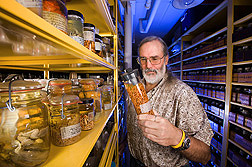This page has been archived and is being provided for reference purposes only. The page is no longer being updated, and therefore, links on the page may be invalid.
|
|
ARS Parasite Collections Assist Research and Diagnoses
By Sharon DurhamJanuary 28, 2010
Collections of organisms that cause harm, disease and damage are important in allowing Agricultural Research Service (ARS) scientists to explore the diversity, evolution, and distribution of parasites and pathogens.
ARS researchers have assembled and maintained invertebrate protist collections at three locations for the purpose of in-house and joint projects. Protists are organisms with simple cellular structures, and can live in any environment that contains water.
At the Center for Medical, Agricultural and Veterinary Entomology (CMAVE), in Gainesville, Fla., researchers are using a collection of microsporidia to act as soldiers of biological warfare at the tiniest level against red imported fire ants.
CMAVE entomologist David Oi is using species of spore-producing insect pathogens, such as Kneallhazia solenopsae, to bring about declines in red imported fire ant (Solenopsis invicta) populations. In Argentina, these infectious soldiers are associated with localized declines of 53 percent to 100 percent in fire ant populations, according to Oi.
In addition, Oi and CMAVE colleagues Sanford Porter and Steven Valles were able to get K. solenopsae to infect phorid flies without harming them. That’s important because phorid flies may serve as vectors to infect red imported fire ants with the microsporidia—perhaps facilitating the spread of infection to other colonies.
Invertebrate protist collections are also maintained at ARS facilities in Sidney, Mont., and Manhattan, Kan.
ARS also keeps archival collections of parasites, such as tapeworms, for research, identification and diagnostic purposes. The vast majority of these are in the U.S. National Parasite Collection, curated by zoologist Eric Hoberg in the ARS Animal Parasitic Diseases Laboratory in Beltsville, Md.
This collection was established in 1892 and is among the largest parasite collections in the world. It holds more than 20 million catalogued specimens representing nematodes, tapeworms, flukes and some parasitic arthropods, such as fleas, ticks and lice. Such archives provide a foundation to identify shifting geographic and host ranges for parasites and diseases that may emerge with accelerated global climate change.
Read more about this and other important collections in the January 2010 issue of Agricultural Research magazine.
ARS is the primary intramural scientific research agency of the U.S. Department of Agriculture.

